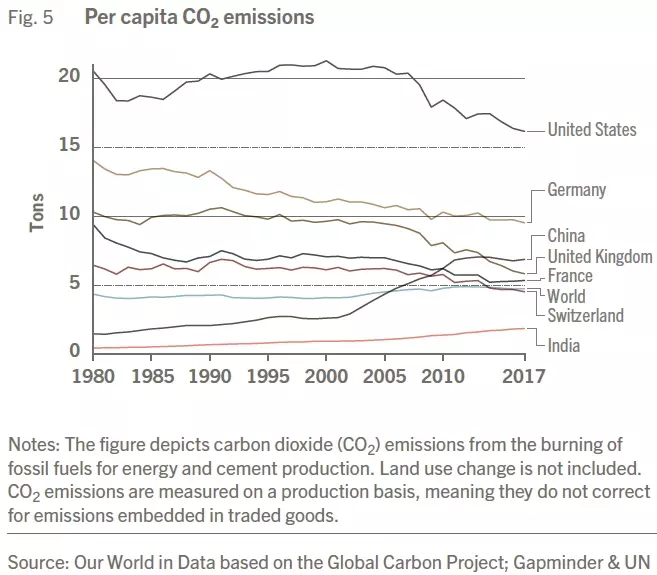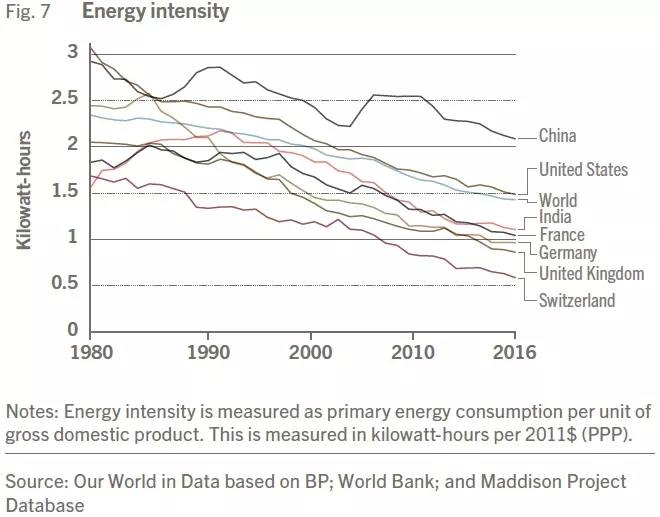Comments
- No comments found

The policy challenge of climate change is not likely to have a single magic bullet answer, but rather will require a cluster of answers.
In addition, it seems extremely unlikely to me that world energy production is going to decline any time soon, especially given the fact that only about 16% of global population lives in “high-income” countries as defined by the World Bank, and the other 84% are strongly desirous of a standard of living that will require higher energy consumption. Thus, the question is how to produce the quantity of energy that will be demanded in the future in a way that will be cost-competitive and also create lower environmental costs (by which I include costs of conventional air pollution from burning fossil fuels as well as issues of carbon emissions and climate change). It is fundamentally a question to be addressed by the cluster of technologies that affect energy production, storage, and consumption.
David Hémous addresses these questions in “Green innovation policies: Economics and climate change” (UBS Center for Economics and Society at the University of Zurich). He writes:
How responsive is innovation to climate policy? … We will see that innovation is key to ensure economic growth while preserving the environment, but innovation is not a silver bullet. First, there is not a single innovation that will reduce our dependence on fossil fuels; instead, we will need many (sometimes incremental) innovations in energy-saving technologies and in clean energy. Second, innovation is not manna from heaven, and it is not even necessarily clean. Instead, the direction of innovation responds to incentives and to policies, which means that policies should be designed taking their induced effect on clean (or dirty) innovation into account.
Hémous points out that per capita emissions of carbon dioxide have been shrinking for the world as a whole, and also for many advanced economies. However, substantial differences in per capita carbon emissions remain even among high-income countries:
“[T]he correlation between income and emissions is far from perfect. Switzerland is below the world average, France is close to it (and below it once we take changes in land use into account), but clearly both countries are relatively rich. Such cross-country differences reflect differences in technologies (how electric power is produced, how well buildings are insulated,
etc.) and consumption choices (what type of cars are popular, how far people live from work, etc.).”

The key driving force here is the energy needed to produce a given amount of GDP–commonly known as “energy intensity”–has been falling all around the world. A substantial part of the reason is that as economies evolve, their economies shift from energy-hungry production of goods to a less energy-intensive production of services and knowledge. The growth of their GDP is less about “more” and instead focused on “better.”

Hémous describes his own research focused on automotive engines. He looks at “clean” innovations that offer alternatives to fossil fuel engines: “grey” innovations that make fossil fuel engines more efficient–but for that reason can also lead to a “rebound effect” of additional driving; and “dirty” innovations that tend to lead to higher emissions. Looking at “3,412 international firms over the period 1986–2005. We find that a 10% increase in fuel prices leads to 8.5% more clean innovations and 8.3% less purely dirty innovations 2 years later, with no statistically significant effect on grey innovations.”
The lesson here is a general one: the direction of technological change is not fully predetermined by the discoveries of scientists and engineers, but instead responds to economic incentives. Development of new pharmaceuticals, to choose another example, responds to the size of the perceived market–which may be quite different from the potential health benefits. Some technologies may be better at replacing labor and displacing jobs; other technologies may be better at complementing labor and raising wages. When it comes to energy, some technologies will be greener than others, and the incentives for a greener path can come in the form of price signals, regulations, and support for research and development.
Timothy Taylor is an American economist. He is managing editor of the Journal of Economic Perspectives, a quarterly academic journal produced at Macalester College and published by the American Economic Association. Taylor received his Bachelor of Arts degree from Haverford College and a master's degree in economics from Stanford University. At Stanford, he was winner of the award for excellent teaching in a large class (more than 30 students) given by the Associated Students of Stanford University. At Minnesota, he was named a Distinguished Lecturer by the Department of Economics and voted Teacher of the Year by the master's degree students at the Hubert H. Humphrey Institute of Public Affairs. Taylor has been a guest speaker for groups of teachers of high school economics, visiting diplomats from eastern Europe, talk-radio shows, and community groups. From 1989 to 1997, Professor Taylor wrote an economics opinion column for the San Jose Mercury-News. He has published multiple lectures on economics through The Teaching Company. With Rudolph Penner and Isabel Sawhill, he is co-author of Updating America's Social Contract (2000), whose first chapter provided an early radical centrist perspective, "An Agenda for the Radical Middle". Taylor is also the author of The Instant Economist: Everything You Need to Know About How the Economy Works, published by the Penguin Group in 2012. The fourth edition of Taylor's Principles of Economics textbook was published by Textbook Media in 2017.
Leave your comments
Post comment as a guest